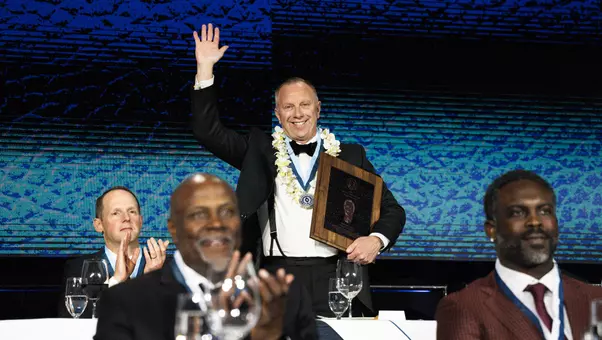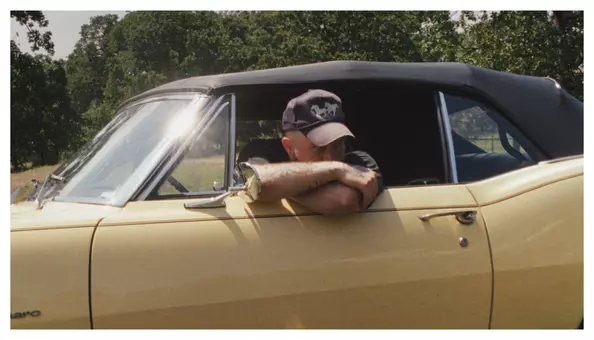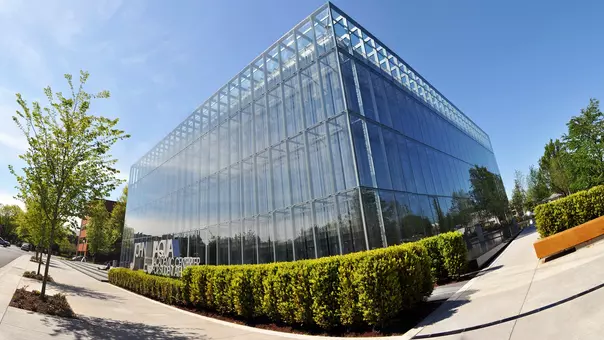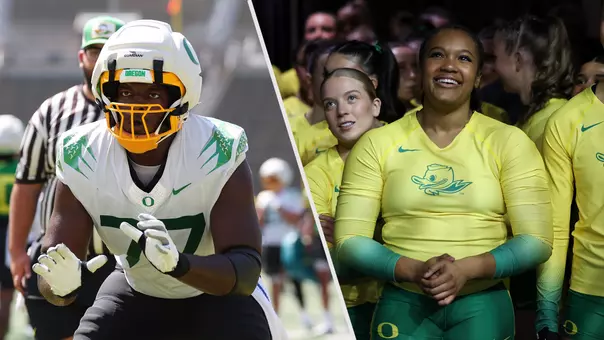
Oral History: The O Turns 20, Part II
08/22/19 | General, @GoDucksMoseley
This season marks 20 years since UO Athletics and Nike unveiled the now iconic logo. Read about the reception of the new logo as it was debuted by the football team but was soon adopted by the entire university.
On Dec. 23, 1998, the University of Oregon football program unveiled Nike-designed uniforms that featured a new logo. In place of the classic, interlocking U-O was a new O that featured an outline of the Autzen Stadium perimeter around an oval that represented Hayward Field. (Click here if you missed Part I, on the conception of the new logo.) The new O was originally intended for use by the football team, but was quickly adopted by the entire athletic department and ultimately the university as a whole. First, though, designers had to conceive of its rollout.
TINKER HATFIELD, Nike vice president for design and special projects: We mocked up a helmet that had this futuristic look (which the Ducks debuted for the 1999 season). It was a deep green that shifted to blue in light, meant to mimic the head of a Mallard duck.
TODD VAN HORNE, Nike's creative director for apparel: We work as a team at Nike. Good ideas come from anywhere and everywhere. In a brainstorm design meeting about the Ducks' uniforms (once the O was finalized), one of our product directors, Tom Creighton, said, 'I was walking around the Nike campus that other day, and I saw some Mallard ducks in the Nike lake. The way their heads color shift in the light is really cool'. The light bulb went on from myself and the rest of the team.
But then we needed to find a way to create it. We contacted 3M, who created color-shifting paint for car finishes. But, they had never formulated this type of paint for the high-density plastics that are used for football helmets. This took several months of trial and error to get the formula right, and the right color. Once it was created, we needed to get the color on a helmet, and get the process and paint type approved from the helmet manufactures; they do rigorous testing to make sure any type of paint does not degrade the base material for safety reasons.
No one had ever requested this of them before and they didn't like it. They owned their own paints and process, and they saw this as a threat. They failed three rounds of samples. I believe they just wanted us to give up, but we didn't. If we could be successful, we knew this would be a unique brand element that played into Oregon's innovation and identity. Who else's helmet could reflect the uniqueness of their region, nature, and mascot? The Oregon Ducks with a Mallard helmet color of course. After several phone meetings with 3M and helmet manufacturers, tweaks of the formula from 3M, and explanation of our goal … we finally passed helmet testing.
We had a local vendor, "Blowsion," paint some mock ups, and then we were ready to show Phil Knight and Coach Bellotti.
HATFIELD: We took it to Phil (Knight) with a model that had the new O on one side, but not the other, for comparison's sake. He goes, 'Oh man, don't put that O on there!' He thought the helmet was awesome on its own.
We also considered the idea of only having the logo on one side. I said, well, I don't know – if we're talking about rebranding, the O itself seems pretty important. And Knight goes, just take it down and ask Coach Bellotti.
MIKE BELLOTTI, UO football head coach, 1995-2008: I'm a symmetric person; I want symmetry. I also thought the O was something unique, and it helped brand us. The helmets were unique also. But I loved the look of the O, on that helmet with that finish. So it was easy. I said, yeah, let's put it on both sides.
HATFIELD: We came back and told Phil that's what Mike wanted and he was like, 'Damn it! But OK, all right, whatever you want.' He was kind of bummed, because he really loved that helmet, with the unique color shift. But I think it was obviously the right move.
The football team wore uniforms featuring the new logo – on both sides of the new helmet – for the 1999 season. That year, a sophomore named Joey Harrington took over at quarterback in the middle of the season, leading the Ducks to a nine-win campaign and a Sun Bowl berth. A year later, Oregon won a school-record 10 games, and in 2001 the Ducks capped an 11-win season with a Fiesta Bowl win.
ARLYN SCHAUFLER, CEO and former merchandise manager, The Duck Store: This is completely anecdotal, but I thought about a third of the people loved (the new logo); a third of our customers said, eh, maybe it'll grow on me; and a third said, why are you changing it? The following year, two-thirds loved it, and the rest said, it's kind of growing on me. And by year three, everyone was all in.
HATFIELD: I got hate mail. People called me up going, what the hell are you doing? After the first season, we went on to win some big football games, and Joey Harrington took over the team. And then I started getting phone calls from some of the same alumni going, oh, that is so awesome!
BELLOTTI: It was amazing the response that we got (from recruits). In fact, at some point, we had to narrow it down a little bit because we had so many people that were interested, and more than we could handle from the standpoint of our manpower to evaluate.
VAN HORNE: The UO President at this time was Dave Frohnmayer, who was there and supportive in the final pitch to the athletic department. He understood that brand distinction could create University destination. Within two years, the O was adopted by the University as the primary brand symbol. The growth of interest and enrollment in the University is self-evident from 1990 to date.
SCHAUFLER: It created a lot of excitement. The Internet wasn't all that big yet, and in those days we were probably doing 60 to 70 percent of total Duck gear sales worldwide. It's safe to say we had a 30 percent increase year over year for a few years after the O first came out. We couldn't order enough, and Nike couldn't provide enough. We'd tell people, if you want it, you better get it today. Because it won't be here tomorrow.
KYLE HENLEY, UO vice president for university communications: As the O began to take root, it became something more than a symbol for athletics. It's a perfect symbol, because it can represent athletics but also an O can encompass lifelong learning. It can instill a sense of community, which is something that we hear from people – that they can find their place here. There's so many elements of what our brand is and what we stand for that the O encompasses.
KELLY GRAVES, UO women's basketball coach: It's something I noticed even before I got here and that, quite frankly, was one of the reasons that the job was so attractive – to be associated with all those things the O stands for. I thought about cool, I thought about uniforms, I thought about Nike, I thought about flash.
CHELSEA GAMBLE, UO lacrosse coach: With women's lacrosse having its roots predominantly on the East Coast, our staff travels the entire country to recruit. With the brand of Oregon, and having the O embroidered on the latest Nike gear, no matter where we are, everyone knows we're Oregon.
GRAVES: It's a hot brand. You go around the country to different places, and quite frankly around the world, and you see the O.
HENLEY: This is one of the most powerful brands within higher education, and we're incredibly fortunate that we have this symbol that really does represent one thing in the athletics realm, but which has come to represent our excellence and everything the institution stands for academically and from a research perspective. You walk around other countries and see people with an O on their hat, and immediately have this connection, a shared experience and a shared identity, and a shared appreciation for the institution. We're in an incredibly enviable position.
JOEY HARRINGTON, UO quarterback, 1998-2001: What's really cool is how it has transcended football. Whether it was just a marketing slogan, 'throwing your O' has become a symbol of the university. It's funny to think about how that has grown from where it actually came from. I was the first one to be captured in that moment and put on the front page of the newspaper, after the Civil War in 2001, and what I was trying to do was signal the marching band director. When he wanted the band to play the fight song, he'd put his hands in the shape of an O. And as I was leaving Autzen for the last time, I wanted to hear the fight song one more time. And now people have adopted it.
HATFIELD: The O is now a mark of excellence. And we need to continue to support that notion, and the idea of innovation.
BELLOTTI: It came about at a time when everything was changing. And now it seems like it's iconic, and it's not going anywhere.
TODD VAN HORNE, Nike's creative director for apparel: I think the O is bedrock now. It's foundational. What we do with elements around it – fonts, wings, colors – those aren't stuck in time. But the O is like the shape of the Nike swoosh. It's simple and pure; there's no reason to change. It communicates who you are faster than words.
To honor the 20th Anniversary of the O, click here: Goducks.com/20thAnniversary


